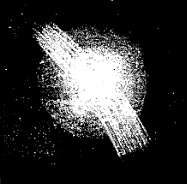 Coma and twin tails of the Great Comet of 1823. | |
| Discovery | |
|---|---|
| Discovered by | Nell de Bréauté |
| Discovery date | December 29, 1823 |
| Designations | |
| 1823; Great Comet of 1823, Comet De Bréauté-Pons | |
| Orbital characteristics | |
| Epoch | 1824 Feb 15.0(UT)[1] |
| Perihelion | 0.226742 AU |
| Eccentricity | 1.0 |
| Inclination | 103.8194 ° |
| Last perihelion | 1823 Dec 09.93400000 |
The Great Comet of 1823, also designated C/1823 Y1 or Comet De Bréauté-Pons, was a bright comet visible in the last month of 1823 and the first months of 1824.
It was independently discovered by Nell de Bréauté at Dieppe on December 29, by Jean-Louis Pons on the morning of December 30, and by Wilhelm von Biela at Prague on the same morning.[2] It was already visible to the naked eye when discovered: Pons initially thought he was seeing smoke from a chimney rising over a hill, but continued observing when he noticed it did not change appearance. He was later to note that the comet was, puzzlingly, more easily visible to the naked eye than through a telescope.[3]
The comet was particularly known at the time for exhibiting two tails, one pointing away from the Sun and the other (termed an "anomalous tail" by Harding and Olbers)[4] pointing towards it.
Caroline Herschel recorded an observation of the comet on January 31, 1824 as the last entry in her observing book.[5]
Pons was also the last astronomer to detect the comet, on April 1, 1824.
References[edit]
- ^ Alan Chamberlin. "JPL Small-Body Database Browser". Ssd.jpl.nasa.gov. Retrieved 2016-01-20.
- ^ Kronk, G. Cometography: volume 2, CUP, 2003, pp.62-3. Some sources give December 24 as its discovery date, but this may be an error.
- ^ Kronk, p.64
- ^ Sekanina, Z.; Hanner, M. S.; Jessberger, E. K.; Fomenkova, M. N. (2001). "Cometary Dust". In Grun, E.; Gustafson, B. A. S.; Dermott, S. F.; Fechtig, H. (eds.). Interplanetary Dust. Heidelberg: Springer. p. 112. ISBN 3-540-42067-3.
- ^ Olson, Roberta J. M.; Pasachoff, Jay M. (2012). "The Comets of Caroline Herschel (1750–1848), Sleuth of the Skies at Slough". Culture and Cosmos. 16 (1–2): 9. arXiv:1212.0809. Bibcode:2012arXiv1212.0809O. doi:10.46472/CC.01216.0213. S2CID 117934098.
External links[edit]


Well, that’s interesting to know that Psilotum nudum are known as whisk ferns. Psilotum nudum is the commoner species of the two. While the P. flaccidum is a rare species and is found in the tropical islands. Both the species are usually epiphytic in habit and grow upon tree ferns. These species may also be terrestrial and grow in humus or in the crevices of the rocks.
View the detailed Guide of Psilotum nudum: Detailed Study Of Psilotum Nudum (Whisk Fern), Classification, Anatomy, Reproduction